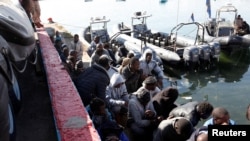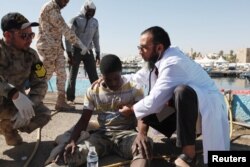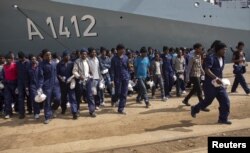European governments are weighing whether to order naval forces to move into Libyan territorial waters to confront people smugglers, a new phase in a nine-month naval interdiction that has seen 83 large smuggler boats destroyed or impounded off the coast of Libya.
EU officials said they are waiting for the new United Nations-mediated government in Tripoli to give the go-ahead for European warships to operate within Libyan territorial waters, despite the fact the new Government of National Accord is struggling to establish its own authority on the fractured North African state.
Britain’s Prime Minister David Cameron has been at the forefront of European leaders arguing for a more forward-leaning mission for European naval vessels attached to Operation Sophia, which was set up after 800 migrants drowned in the Mediterranean last April.
The naval interdiction wasn’t operational until last July.
European summit
At a European summit in March, Cameron said, "What we’re talking about today is actually busting the business model of these people smugglers, and so therefore breaking the link between getting in a boat and getting settlement in Europe.”
The naval interdiction under the command of an Italian, Rear Admiral Enrico Credendino, has had some success in deterring would-be asylum-seekers from making the crossing, and as a consequence there has been a dramatic rise in the number of migrants now held in more than 18 overcrowded Libyan detention centers.
With the sailing season arriving and calmer waters in the Mediterranean, there has been an increase in crossings.
Three times as many migrant crossings from Libya to Europe were made last month compared to March 2015, U.N. officials said.
Most of those making the crossing are economic migrants from sub-Saharan Africa with a large percentage coming from Nigeria, Gambia, Senegal and Mali.
Credendino told the Italian news agency ANSA that Operation Sophia had made life much more difficult for the smugglers, who have stopped using large wooden boats that can carry as many as 500 migrants and now rely on smaller vessels carrying about 100 people.
He said migrants are still drowning in Libyan territorial waters.
Inshore patrols
To save more lives and fight traffickers more effectively, his forces would have to be “invited by the national unity government,” to patrol inshore, joining Libyan coast guard vessels to intercept migrants as they embark and return them to Libyan shores, he said.
Critics of Operation Sophia worry the interdiction has done little to catch traffickers or disrupt their criminal networks that reach deep into Africa and often end up picking migrants up and then landing them in Italy.
“The EU is doing an important job saving lives, but if its primary mission is catching smugglers, it is not doing it, thanks to its own methods,” said Sicilian magistrate Carmelo Zucchero. “Traffickers now send out unstable dinghies steered by migrants because they know they will be picked up quickly.”
More than a quarter-million
Italian officials fear that as many as 270,000 migrants may flood in from North Africa this year, with record numbers making the perilous journey across the Mediterranean from Libya. In 2014, more than 170,000 migrants crossed from Libya to Europe, mostly before the Aegean migration route became more organized.
Officials say 19,000 migrants have arrived in Italy via Libya this year.
The migrant surge is being attributed to the European Union crackdown on asylum-seekers trying to get from Turkey to Greece by crossing the Aegean, forcing them instead to attempt the more dangerous route from North Africa.
Last year, nearly 90 percent of the war refugees from the Middle East and migrants from Africa who arrived in Europe went via Turkey. Libyan smugglers are stepping up their business efforts to once again command the main migration route to Europe.
Admiral Credendino said he expects not only there to be a revival of the Libyan migration route when it comes to African migrants, but a surge of Mideast refugees attempting longer sea crossings to Europe from Lebanon, Turkey and even directly from Syria.
Last year, when Operation Sophia was being set up, Europe’s defense chiefs feared a shift in objectives and warned their political superiors the planned mission to stop migrant-smuggling boats crossing the Mediterranean could lead to land operations and possible clashes with Islamic State’s affiliate in Libya or armed groups linked with the highly lucrative trade.
Warnings
The warning was contained in a 10-page classified document by the military defense chiefs of the 28 EU member states, obtained and posted by WikiLeaks.
In it, defense chiefs noted there will be a serious threat to European forces mounting the interdiction, during activities such as boarding and when operating on land or in proximity to an unsecured coastline, or during interaction with non-seaworthy vessels.
They added the potential presence of hostile forces, extremists or terrorists should be taken into consideration.













